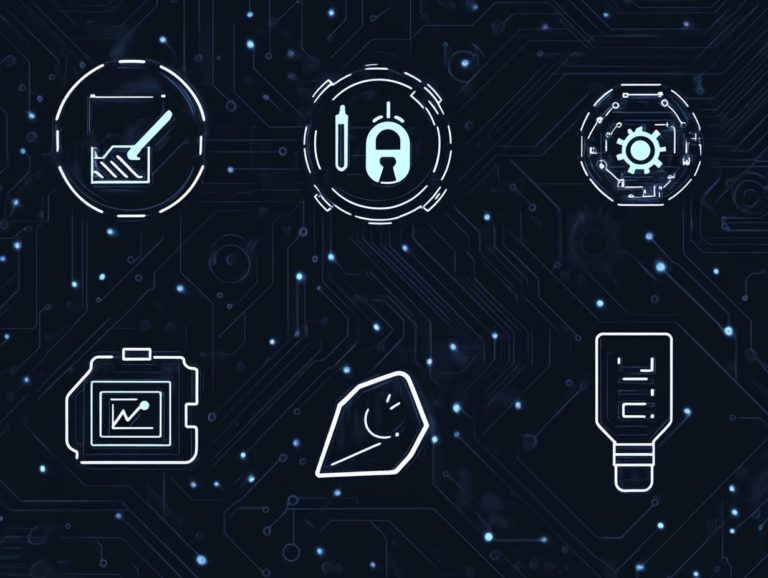the relationship between incident response and compliance
In today s digital landscape, the convergence of incident response and compliance is more crucial than ever. As you navigate increasing threats and regulatory pressures, it s essential to grasp how to align your incident response strategies with compliance requirements.
In this article, we explore key regulations and standards while outlining an effective incident response framework. We also share best practices for seamlessly integrating compliance into your response strategies. By enhancing both your incident response and compliance efforts, you can significantly bolster your security posture and mitigate risks.
Continue reading to discover how these elements synergistically fortify your organization s defenses.
Contents
- Key Takeaways:
- The Importance of Incident Response and Compliance
- Compliance Regulations and Standards
- Incident Response Framework
- Compliance and Incident Response: Best Practices
- Benefits of Effective Incident Response and Compliance
- Preguntas Frecuentes
- La Importancia de la Respuesta a Incidentes y el Cumplimiento
- Cu l es la relaci n entre la respuesta a incidentes y el cumplimiento?
- C mo se superponen la respuesta a incidentes y el cumplimiento?
- La respuesta a incidentes impacta el cumplimiento?
- Por qu es crucial que las organizaciones construyan una relaci n s lida entre la respuesta a incidentes y el cumplimiento?
- C mo pueden las organizaciones asegurar una relaci n s lida entre la respuesta a incidentes y el cumplimiento?
- Puede la respuesta a incidentes ser una herramienta para mantener el cumplimiento?
Key Takeaways:

Strong incident response and compliance are your best defenses against data breaches! Compliance regulations and standards guide organizations in implementing necessary incident response measures. Aligning incident response and compliance practices not only mitigates risks but also improves overall security measures for an organization.
The Importance of Incident Response and Compliance
In today s digital landscape, the significance of incident response and compliance cannot be overstated. This is especially true as you navigate an environment rife with cyberattacks.
An effective incident response strategy enables you to manage security incidents with agility. It also plays a crucial role in maintaining compliance with regulatory frameworks.
This approach protects sensitive data and ensures that rules governing data use and protection are followed.
In a world where data breaches can undermine customer trust and result in substantial financial consequences, integrating robust incident response strategies with compliance requirements is vital for achieving operational integrity and fostering your ability to handle cyber threats.
Understanding the Connection
Understanding the connection between incident response and compliance is essential for organizations seeking to elevate their cybersecurity posture, particularly regarding the role of incident response in business continuity.
By crafting a well-defined incident response plan, you can effectively address various regulatory requirements. This means not only safeguarding sensitive data but also steering clear of potential penalties.
This structured approach streamlines your communication procedures during incident management. It ensures all relevant stakeholders are informed and engaged throughout the process.
Implementing proactive threat detection measures is crucial for identifying vulnerabilities before they can be exploited, significantly reducing risks.
This comprehensive strategy gives you the power to be prepared, vigilant, and ultimately more resilient against cyber threats.
Compliance Regulations and Standards
Compliance regulations and standards are crucial in guiding your organization’s approach to cybersecurity and data protection.
Significant frameworks like the General Data Protection Regulation (GDPR), the Health Insurance Portability and Accountability Act (HIPAA), and the Payment Card Industry Data Security Standard (PCI DSS) serve as benchmarks for achieving legal compliance. By following these guidelines, you not only safeguard sensitive information but also reinforce trust with customers and stakeholders.
Overview of Key Regulations

Regulations like GDPR, HIPAA, and PCI DSS offer a solid framework for managing data privacy and ensuring compliance. These regulations lay out essential principles for the collection, storage, and processing of personal data, requiring you to implement robust security measures.
For example, GDPR emphasizes the significance of consent and the right to access data. HIPAA is focused on protecting sensitive health information, demanding strict controls to mitigate breaches.
Understanding these regulations is vital for shaping your incident response strategies. You need to address security incidents while also demonstrating compliance through documented procedures.
Safeguarding data privacy isn’t just a regulatory checkbox; it builds trust among your customers and protects your organization s reputation in an ever-evolving digital landscape.
Act now to strengthen your defenses and stay ahead of potential threats.
Incident Response Framework
An effective incident response framework is crucial for addressing security incidents efficiently. It encompasses key components, including a dedicated incident response team, containment strategies, recovery processes, and digital forensics methods.
These elements guide the entire incident lifecycle, from identification to resolution, ensuring that you are well-prepared to tackle any situation that arises.
Key Components and Best Practices
To establish a robust incident response process, incorporate essential components and best practices. These include a well-defined incident response plan, clear escalation procedures, thorough reviews after incidents, and a commitment to ongoing improvement.
These elements form the backbone of a strong cybersecurity strategy. They empower you to react quickly and improve your readiness for future threats.
A comprehensive incident response plan outlines specific roles and responsibilities, ensuring that every team member understands their tasks during an incident.
Clear escalation procedures minimize confusion and facilitate timely communication. Detailed reviews after incidents allow you to document critical lessons learned and integrate them into future strategies.
By embracing a culture of ongoing improvement, you position your organization to adapt to the evolving landscape of cyber threats, ultimately strengthening your overall resilience against potential breaches.
Compliance and Incident Response: Best Practices
Aligning your incident response with compliance best practices is crucial for navigating the intricate landscape of regulatory requirements.
This approach allows you to manage security incidents effectively while maintaining clear communication with your stakeholders throughout the process.
How to Align Incident Response with Compliance

Aligning your incident response plan with compliance frameworks requires regular risk assessments and efficient threat detection protocols.
Prioritize continuous monitoring of your systems and processes to swiftly identify and address potential vulnerabilities.
Regularly updating your incident response plan is essential; it should evolve with the regulatory landscape and emerging threats.
Fostering a culture of compliance and encouraging open communication between your IT and compliance teams creates a robust framework that meets legal obligations while enhancing your overall security posture.
Staying proactive through training sessions and simulations will further strengthen your readiness to respond effectively to incidents as they arise.
Benefits of Effective Incident Response and Compliance
The advantages of an effective incident response and compliance strategy go far beyond simply ticking regulatory boxes.
They include elevated risk management, heightened customer trust, strengthened operational integrity, and robust data security measures that together safeguard your organization from potential threats.
Improving Security and Mitigating Risks
Improving security and mitigating risks requires implementing proactive measures that effectively address potential operational issues. This ensures threats are swiftly eradicated before they escalate into data breaches.
Here are some effective measures you can take:
- Regular security audits
- Comprehensive employee training programs
- The deployment of advanced threat detection systems
By adopting these preemptive strategies, you not only fortify your defenses but also cultivate a culture of awareness among your staff.
For instance, in the financial sector, having a well-drilled incident response team can rapidly contain threats, significantly reducing potential losses and regulatory repercussions. Similarly, in healthcare, prompt intervention during cyber incidents has been crucial in protecting sensitive patient data, highlighting the immense value of preparation and responsiveness in effectively mitigating risks.
Preguntas Frecuentes
La Importancia de la Respuesta a Incidentes y el Cumplimiento
La respuesta a incidentes y el cumplimiento son esenciales para la seguridad de las organizaciones. Entender c mo se relacionan puede ayudar a prevenir violaciones de seguridad y sanciones legales.
Cu l es la relaci n entre la respuesta a incidentes y el cumplimiento?

La respuesta a incidentes es un componente clave del cumplimiento. Reaccionar ante incidentes de seguridad es fundamental para adherirse a las reglas y regulaciones establecidas por organismos gubernamentales y organizaciones. Un plan de respuesta a incidentes s lido ayuda a prevenir y mitigar incidentes de seguridad que pueden afectar el cumplimiento.
C mo se superponen la respuesta a incidentes y el cumplimiento?
Ambos requieren que las organizaciones adopten un enfoque proactivo hacia la seguridad. Esto incluye realizar evaluaciones de riesgo y escaneos de vulnerabilidades de manera regular.
Tambi n implican la documentaci n de pol ticas y procedimientos para asegurar que se sigan los protocolos adecuados. Adem s, requieren un monitoreo y evaluaci n continuos de las pr cticas de seguridad para identificar reas de mejora.
La respuesta a incidentes impacta el cumplimiento?
S , una respuesta a incidentes mal ejecutada puede provocar incumplimientos de regulaciones como el GDPR o la HIPAA. En contraste, un plan de respuesta a incidentes bien estructurado puede ayudar a cumplir con los requisitos y evitar sanciones.
Por qu es crucial que las organizaciones construyan una relaci n s lida entre la respuesta a incidentes y el cumplimiento?
Es vital que las organizaciones mantengan la seguridad y privacidad de sus datos. Un plan de respuesta efectivo permite identificar y responder r pidamente a incidentes de seguridad, minimizando su impacto.
Los requisitos de cumplimiento tambi n ayudan a las organizaciones a mantenerse actualizadas con las mejores pr cticas y regulaciones recientes, mejorando su postura general de ciberseguridad.
C mo pueden las organizaciones asegurar una relaci n s lida entre la respuesta a incidentes y el cumplimiento?
Primero, las organizaciones deben realizar una evaluaci n de riesgos exhaustiva para identificar amenazas y vulnerabilidades. Luego, desarrollen un plan de respuesta a incidentes integral alineado con los requisitos de cumplimiento y actual cenlo regularmente.
Adem s, es esencial integrar los requisitos de cumplimiento en los procedimientos de respuesta y capacitar a los empleados sobre protocolos de respuesta y cumplimiento.
Puede la respuesta a incidentes ser una herramienta para mantener el cumplimiento?
S , puede ayudar a identificar y abordar incidentes de seguridad potenciales r pidamente, previniendo violaciones de cumplimiento. Un plan bien ejecutado proporciona evidencia de cumplimiento durante auditor as.
Ejercicios regulares de respuesta y capacitaci n tambi n ayudan a identificar brechas en los esfuerzos de cumplimiento y hacer los ajustes necesarios.
Act a ahora y revisa tu plan de respuesta a incidentes para asegurar el cumplimiento y la seguridad.






